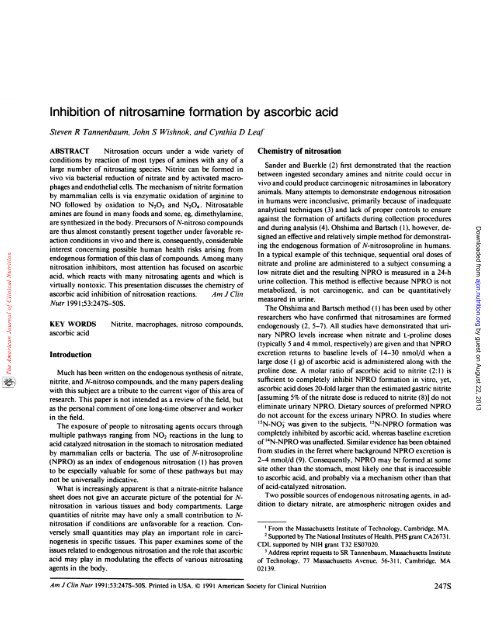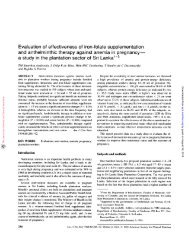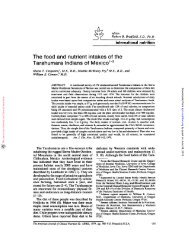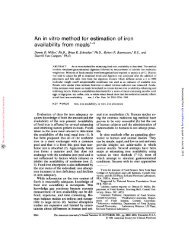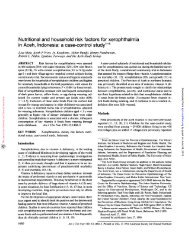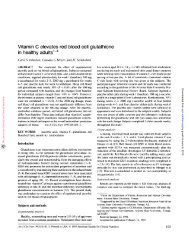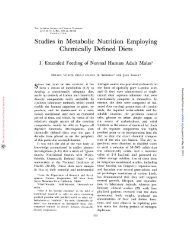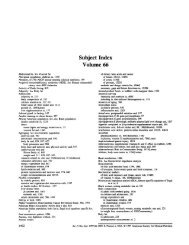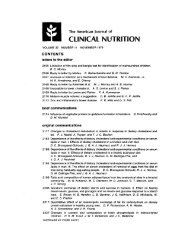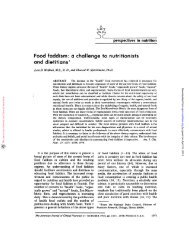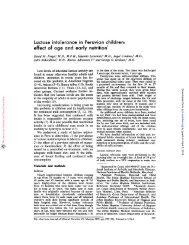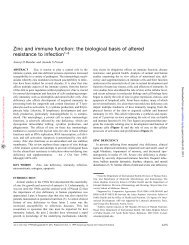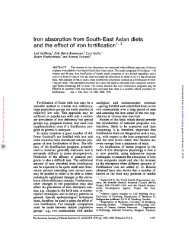Inhibition of nitrosamine formation by ascorbic acid - American ...
Inhibition of nitrosamine formation by ascorbic acid - American ...
Inhibition of nitrosamine formation by ascorbic acid - American ...
You also want an ePaper? Increase the reach of your titles
YUMPU automatically turns print PDFs into web optimized ePapers that Google loves.
<strong>Inhibition</strong> <strong>of</strong> <strong>nitrosamine</strong> <strong>formation</strong> <strong>by</strong> <strong>ascorbic</strong> <strong>acid</strong><br />
Steven R Tannenbaum, John S Wishnok, and Cynthia D Leaf<br />
ABSTRACt’ Nitrosation occurs under a wide variety <strong>of</strong><br />
conditions <strong>by</strong> reaction <strong>of</strong> most types <strong>of</strong> amines with any <strong>of</strong> a<br />
large number <strong>of</strong> nitrosating species. Nitrite can be formed in<br />
vivo via bacterial reduction <strong>of</strong> nitrate and <strong>by</strong> activated macrophages<br />
and endothelial cells. The mechanism <strong>of</strong>nitrite <strong>formation</strong><br />
<strong>by</strong> mammalian cells is via enzymatic oxidation <strong>of</strong> arginine to<br />
NO followed <strong>by</strong> oxidation to N203 and N204 . Nitrosatable<br />
amines are found in many foods and some, eg, dimethylamine,<br />
are synthesized in the body. Precursors <strong>of</strong>N-nitroso compounds<br />
are thus almost constantly present together under favorable reaction<br />
conditions in vivo and there is, consequently, considerable<br />
interest concerning possible human health risks arising from<br />
endogenous <strong>formation</strong> <strong>of</strong>this class <strong>of</strong>compounds. Among many<br />
nitrosation inhibitors, most attention has focused on <strong>ascorbic</strong><br />
<strong>acid</strong>, which reacts with many nitrosating agents and which is<br />
virtually nontoxic. This presentation discusses the chemistry <strong>of</strong><br />
<strong>ascorbic</strong> <strong>acid</strong> inhibition <strong>of</strong> nitrosation reactions. Am J C/in<br />
Nuir<br />
199 1;53:247S-50S.<br />
KEY WORDS Nitrite, macrophages, nitroso compounds,<br />
<strong>ascorbic</strong><br />
Introduction<br />
<strong>acid</strong><br />
Much has been written on the endogenous synthesis <strong>of</strong> nitrate,<br />
nitrite, and N-nitroso compounds, and the many papers dealing<br />
with this subject are a tribute to the current vigor <strong>of</strong>this area <strong>of</strong><br />
research. This paper is not intended as a review <strong>of</strong>the field, but<br />
as the personal comment <strong>of</strong>one long-time observer and worker<br />
in the field.<br />
The exposure <strong>of</strong> people to nitrosating agents occurs through<br />
multiple pathways ranging from NO2 reactions in the lung to<br />
<strong>acid</strong> catalyzed nitrosation in the stomach to nitrosation mediated<br />
<strong>by</strong> mammalian cells or bacteria. The use <strong>of</strong> N-nitrosoproline<br />
(NPRO) as an index <strong>of</strong> endogenous nitrosation ( 1 ) has proven<br />
to be especially valuable for some <strong>of</strong> these pathways but may<br />
not be universally indicative.<br />
What is increasingly apparent is that a nitrate-nitrite balance<br />
sheet does not give an accurate picture <strong>of</strong> the potential for N-<br />
nitrosation in various tissues and body compartments. Large<br />
quantities <strong>of</strong> nitrite may have only a small contribution to N-<br />
nitrosation if conditions are unfavorable for a reaction. Conversely<br />
small quantities may play an important role in carcinogenesis<br />
in specific tissues. This paper examines some <strong>of</strong> the<br />
issues related to endogenous nitrosation and the role that <strong>ascorbic</strong><br />
<strong>acid</strong> may play in modulating the effects <strong>of</strong> various nitrosating<br />
agents in the body.<br />
Chemistry <strong>of</strong> nitrosation<br />
Sander and Buerkle (2) first demonstrated that the reaction<br />
between ingested secondary amines and nitrite could occur in<br />
vivo and could produce carcinogenic <strong>nitrosamine</strong>s in laboratory<br />
animals. Many attempts to demonstrate endogenous nitrosation<br />
in humans were inconclusive, primarily because <strong>of</strong> inadequate<br />
analytical techniques (3) and lack <strong>of</strong> proper controls to ensure<br />
against the <strong>formation</strong> <strong>of</strong> artifacts during collection procedures<br />
and during analysis (4). Ohshima and Bartsch (1), however, designed<br />
an effective and relatively simple method for demonstrating<br />
the endogenous <strong>formation</strong> <strong>of</strong> N-nitrosoproline in humans.<br />
In a typical example <strong>of</strong> this technique, sequential oral doses <strong>of</strong><br />
nitrate and proline are administered to a subject consuming a<br />
low nitrate diet and the resulting NPRO is measured in a 24-h<br />
urine collection. This method is effective because NPRO is not<br />
metabolized, is not carcinogenic, and can be quantitatively<br />
measured in urine.<br />
The Ohshima and Bartsch method (I) has been used <strong>by</strong> other<br />
researchers who have confirmed that <strong>nitrosamine</strong>s are formed<br />
endogenously (2, 5-7). All studies have demonstrated that unnary<br />
NPRO levels increase when nitrate and i-proline doses<br />
(typically 5 and 4 mmol, respectively) are given and that NPRO<br />
excretion returns to baseline levels <strong>of</strong> 14-30 nmol/d when a<br />
large dose (1 g) <strong>of</strong> <strong>ascorbic</strong> <strong>acid</strong> is administered along with the<br />
proline dose. A molar ratio <strong>of</strong> <strong>ascorbic</strong> <strong>acid</strong> to nitrite (2: 1) is<br />
sufficient to completely inhibit NPRO <strong>formation</strong> in vitro, yet,<br />
<strong>ascorbic</strong> <strong>acid</strong> doses 20-fold larger than the estimated gastric nitrite<br />
[assuming 5% <strong>of</strong>the nitrate dose is reduced to nitrite (8)] do not<br />
eliminate urinary NPRO. Dietary sources <strong>of</strong>pneformed NPRO<br />
do not account for the excess urinary NPRO. In studies where<br />
‘5N-NO was given to the subjects, ‘5N-NPRO <strong>formation</strong> was<br />
completely inhibited <strong>by</strong> <strong>ascorbic</strong> <strong>acid</strong>, whereas baseline excretion<br />
<strong>of</strong> ‘4N-NPRO was unaffected. Similar evidence has been obtained<br />
from studies in the ferret where background NPRO excretion is<br />
2-4 nmol/d (9). Consequently, NPRO may be formed at some<br />
site other than the stomach, most likely one that is inaccessible<br />
to <strong>ascorbic</strong> <strong>acid</strong>, and probably via a mechanism other than that<br />
<strong>of</strong> <strong>acid</strong>-catalyzed nitrosation.<br />
Two possible sources <strong>of</strong>endogenous nitrosating agents. in addition<br />
to dietary nitrate, are atmospheric nitrogen oxides and<br />
From the Massachusetts Institute <strong>of</strong> Technology, Cambridge, MA.<br />
2 Supported <strong>by</strong> The National Institutes <strong>of</strong>Health, PHS grant CA26731.<br />
CDL supported <strong>by</strong> NIH grant T32 ES07020.<br />
3 Address reprint requests to SR Tannenbaum, Massachusetts Institute<br />
<strong>of</strong> Technology, 77 Massachusetts Avenue, 56-31 1, Cambridge. MA<br />
02139.<br />
Downloaded from ajcn.nutrition.org <strong>by</strong> guest on August 22, 2013<br />
Am J C/in Nutr 1991;53:247S-SOS. Printed in USA. © 1991 <strong>American</strong> Society for Clinical Nutrition 2475
2485 TANNENBAUM ET AL<br />
nitric oxide produced endogenously <strong>by</strong> cells. Nitric oxide is a<br />
labile species that can react rapidly with oxygen yielding NO2,<br />
which exists in equilibrium with the potent nitrosating agents<br />
N2O3 and N204. Subsequent reaction <strong>of</strong>these compounds with<br />
secondary amines would yield <strong>nitrosamine</strong>s; the competing reaction<br />
with water would yield nitrite and nitrate.<br />
The reaction <strong>of</strong> atmospheric nitrogen oxides, particularly nitrogen<br />
dioxide (NO2). with endogenous amines represents another<br />
possible nitrosation pathway. Cigarettes, eg, are one significant<br />
source <strong>of</strong> exposure; cigarette smoke contains as much<br />
as 1000 ppm nitrogen oxides (10). After administration <strong>of</strong> dimethylamine<br />
to mice followed <strong>by</strong> exposure to NO2 at levels 20-<br />
50 times higher than normal atmospheric concentrations,<br />
Mirvish et al ( I 1) found increased levels <strong>of</strong> N-nitrosodimethylamine<br />
(NDMA) in the urine. Garland et al (12) reported a<br />
positive correlation between atmospheric NO2 levels and NDMA<br />
excretion in human subjects. although it could not be determined<br />
whether the increase was due to additional nitrosation <strong>of</strong> dimethylamine<br />
in vivo or nitrosation in the air and subsequent<br />
inhalation <strong>of</strong> NDMA. There was no correlation, however, between<br />
urinary NPRO and atmospheric NO2 concentration. This<br />
could indicate that the urinary NDMA increase was a result <strong>of</strong><br />
inhalation <strong>of</strong> higher levels <strong>of</strong> preformed NDMA in the air or<br />
that proline is nitrosated via a different mechanism or at a different<br />
site than dimethylamine.<br />
Another pathway for endogenous nitrosation may be linked<br />
to the endogenous synthesis <strong>of</strong> nitrate, a mammalian process<br />
( 1 3-1 5) estimated to produce 1 mmol nitrate/d in man under<br />
normal conditions (7, 16). Immunostimulation increases endogenous<br />
nitrate synthesis: eg, a human subject on a nitrate<br />
balance study had a ninefold increase in urinary nitrate excretion<br />
while experiencing nonspecific intestinal diarrhea and fever (17).<br />
Rats treated with Eseherichia co/i Lipopolysacchande endotoxin<br />
(LPS) had similarly augmented urinary nitrate levels. Two other<br />
immunostimulants, carrageenan and turpentine, caused smaller,<br />
although still significant. increases in urinary nitrate in rats (17).<br />
Stuehr and MarIetta ( 1 8) determined that the cell primarily<br />
responsible for immunostimulated nitrate synthesis is the macrophage.<br />
Macrophages and several established macrophage cell<br />
lines, when stimulated with LPS and/or lymphokines, produce<br />
nitrate and nitrite in vitro via intermediate production <strong>of</strong> nitric<br />
oxide ( 19. 20). When suitable secondary amines are added to<br />
growth media containing stimulated macrophages. the corresponding<br />
<strong>nitrosamine</strong>s can be detected in the media (2 1). The<br />
major nitrogen source for these compounds is the terminal<br />
guanido-nitrogen <strong>of</strong>L-arginine (22). Endothelial cells (23), neutrophils<br />
(24), and brain cells (25) also produce nitric oxide from<br />
L-arginine in vitro. This is a general phenomenon occurring<br />
across species lines and in cells from many sources.<br />
We have demonstrated that L-arginine is the precursor <strong>of</strong> endogenously<br />
synthesized nitrate in rats, ferrets, and humans (26).<br />
Following administration <strong>of</strong> an intraperitoneal dose <strong>of</strong> ‘5N2-Larginine,<br />
rats and ferrets excreted ‘5N-NO . Nitrite is not measurable<br />
in mammalian urine because it reacts rapidly with oxyhemoglobin<br />
forming methemoglobin and nitrate (27). In the<br />
rat, LPS-induced immunostimulation was accompanied <strong>by</strong> increased<br />
excreted nitrate along with a parallel increase in incorporation<br />
<strong>of</strong> ‘5N from ‘5N2-L-arginine into nitrate. The wide range<br />
in the LPS-induced increases in excreted nitrate in rats is most<br />
likely attributable to individual variations in response to LPS.<br />
In a similar study, Wagner et al (I 5) treated Sprague-Dawley<br />
rats with LPS and observed a ninefold increase in urinary nitrate<br />
levels and large variations among individuals. They found that<br />
the enhancement <strong>of</strong> excreted nitrate correlated with the magnitude<br />
<strong>of</strong> fever induction. Macrophages are directly activated<br />
<strong>by</strong> LPS, although other cell types which will similarly convert<br />
L-anginine to nitric oxide may also be stimulated directly or indirectly<br />
<strong>by</strong> LPS. Endothelial cells, eg, play a role in vasodilation<br />
as a consequence <strong>of</strong> fever and could, therefore, make a contribution<br />
to the increase in excreted nitrate.<br />
The effects <strong>of</strong>a prolonged period <strong>of</strong>exercise on excreted nitrate<br />
have been examined (28). In this study, two healthy males consumed<br />
a defined low-nitrate diet for 8 consecutive days and did<br />
not exercise nor physically exert themselves except on the fifth<br />
day, when they ran or bicycled almost continuously for 6 h. An<br />
increase in excreted nitrate was observed in the I 2-h urine collection<br />
period during which the subjects exercised. This is the<br />
first time excreted nitrate has been intentionally increased in<br />
humans <strong>by</strong> a means other than dosing with nitrate. Again, elucidating<br />
the cell types involved remains for further investigation.<br />
Bacteria are another cell type capable <strong>of</strong> mediating nitrosation<br />
and their role has been considered in hypotheses regarding the<br />
etiology <strong>of</strong> several cancers. It has been proposed, eg, that the<br />
association between a higher risk <strong>of</strong> gastric cancer and gastric<br />
achlonhydria may be due to increased levels <strong>of</strong> endogenous nitrosation<br />
via the higher populations <strong>of</strong> gastric bacteria which<br />
accompany elevated gastric pH. It was first thought that bacteria<br />
facilitated nitrosation primarily <strong>by</strong> reducing nitrate to nitrite<br />
(29, 30). Subsequent studies have shown that bacteria act directly<br />
in amine nitrosation (3 1-33) and that this activity is linked to<br />
nitrate neductase genes (34-36). E. co/i grown anaerobically in<br />
the presence <strong>of</strong> nitrate form nitrosation products when nitrite<br />
and a suitable amine are added to the media (34). The reaction<br />
mechanism was further elucidated <strong>by</strong> Ji and Hollocher (37),<br />
who demonstrated that NO is produced from nitrite <strong>by</strong> E. co/i<br />
under anaerobic conditions. Nitrosation occurs only after air is<br />
added to the system, indicating that the nitrosating agents are<br />
most likely N2O3 and N2O4.<br />
In summary, studies in humans and animals have clearly<br />
demonstrated that endogenous nitrosation occurs intragastrically<br />
(38) and in at least one other extragastric site. Several types <strong>of</strong><br />
cells including macrophages, endothelial cells, neutrophils, brain<br />
cells, and bacteria produce nitric oxide in vitro under certain<br />
conditions which may be duplicated in the whole animal. Nitrosation<br />
<strong>by</strong> macrophages and bacteria has been demonstrated<br />
in vitro. All <strong>of</strong> these cells, with the exception <strong>of</strong>bacteria, utilize<br />
nitrogen from L-arginine in the production <strong>of</strong> nitric oxide. We<br />
have demonstrated that L-arginine is a nitrogen source for biosynthesized<br />
nitrate in rats, ferrets, and humans. These same nitric<br />
oxide-producing cells may be responsible for this novel oxidation<br />
<strong>of</strong> L-arginine to nitrate in humans. Based on known chemistry<br />
for nitrosation reactions, it is possible that NO produced endogenously<br />
could react with oxygen and, subsequently, nitrosate<br />
secondary amines to produce carcinogenic N-<strong>nitrosamine</strong>s in<br />
vivo.<br />
Chemistry <strong>of</strong> <strong>ascorbic</strong> <strong>acid</strong><br />
Some relevant aspects <strong>of</strong> this topic have been discussed in<br />
greater detail in earlier reports but a summary is appropriate<br />
here. Ascorbic <strong>acid</strong>, under anaerobic conditions, can usually<br />
react with N2O3 , H2NO , and NOX with rates higher in each<br />
Downloaded from ajcn.nutrition.org <strong>by</strong> guest on August 22, 2013
ASCORBIC ACID INHIBITION 2495<br />
case than the corresponding nitrosation rates for amides or dialkyl<br />
amines. Ascorbic <strong>acid</strong> can therefore generally inhibit the<br />
in vitro nitrosation <strong>of</strong>these classes <strong>of</strong>compounds. This property<br />
has been exploited to prevent <strong>nitrosamine</strong> <strong>formation</strong> in foods,<br />
and to some extent, to inhibit in vivo nitrosation.<br />
Ascorbic <strong>acid</strong> thus appears to have potential importance as<br />
an in vivo nitrite scavenger. This potential, however, has yet to<br />
be completely realized; not only are the reactions that occur in<br />
live organisms more complex than might have been expected,<br />
but the in vitro model systems themselves are not straightforward.<br />
The equilibria, eg, involve several nitrosating species that can<br />
react with <strong>ascorbic</strong> <strong>acid</strong> to form NO, which does not nitrosate<br />
amines. Under anaerobic conditions these reactions can then<br />
exhaust the nitrosating capacity <strong>of</strong>the system. Oxygen, however,<br />
can react with NO to form N203 and N2O4 , both <strong>of</strong> which are<br />
capable <strong>of</strong> nitrosation.<br />
Under these circumstances, the <strong>ascorbic</strong> <strong>acid</strong> may be effectively<br />
removed from the system without significantly affecting the<br />
concentration <strong>of</strong> nitrosating species. In addition to these processes,<br />
<strong>ascorbic</strong> <strong>acid</strong> itself can also react directly with oxygen,<br />
undergoing conversion to dehydroascorbate (39, 40).<br />
Evidence now exists that <strong>ascorbic</strong> <strong>acid</strong> is a limiting factor in<br />
nitrosation reactions in people. This has recently been demonstrated<br />
for gastrectomy patients (41) and for patients with chronic<br />
atrophic gastritis (42). The role that <strong>ascorbic</strong> <strong>acid</strong> may play in<br />
inhibiting processes <strong>of</strong> endogenous carcinogenesis has not yet<br />
been fully evaluated but future studies should pay close attention<br />
to the availability <strong>of</strong> reduced <strong>ascorbic</strong> <strong>acid</strong> in various cornpartments<br />
<strong>of</strong> the human body in populations at high risk for<br />
cancer. 13<br />
References<br />
1. Ohshima H, Bartsch H. Quantitative estimation <strong>of</strong>endogenous nitrosation<br />
in humans <strong>by</strong> monitoring N-nitrosoproline excretion in<br />
the urine. Cancer Res 198 l;4l:3658-66.<br />
2. Sander I, Buerkle G. Induction <strong>of</strong> malignant tumors in rats <strong>by</strong> simultaneous<br />
feeding <strong>of</strong> nitrite and secondary amines. Z Krebsforsch<br />
l969;73:54-66.<br />
3. Garland WA, Holowarchenko H, Kuenzig W, Norkus EP, Conney<br />
AH. A high resolution mass spectrometry assay for N-nitrosodimethylamine.<br />
In: Magee P. ed. Banbury report 12: <strong>nitrosamine</strong>s and<br />
human cancer. Cold Spring Harbor, NY: Cold Spring Harbor Laboratories,<br />
1982:183-96.<br />
4. Preussmann R, Eisenbrand G. N-nitrosocarcinogens in the environment.<br />
In: Searle CE, ed. Chemical carcinogens Washington, DC:<br />
<strong>American</strong> Chemical Society, 1984:829-68 (ACS Monograph series<br />
182.)<br />
S. Wagner DA, Shuker DEG, Bilmazes C, et al. Effect <strong>of</strong> vitamins C<br />
and F on endogenous synthesis <strong>of</strong> N-nitrosamino <strong>acid</strong>s in humans:<br />
precursor-product studies with (lS-N)nitrate. Cancer Res l985;45:<br />
65 19-22.<br />
6. H<strong>of</strong>fmann D, Brunnemann KD. Endogenous <strong>formation</strong> <strong>of</strong> N-nitrosoproline<br />
in cigarette smokers. Cancer Res l983;43:5570-74.<br />
7. LeafCD, Vecchio Al, Hotchkiss IH. Influence <strong>of</strong><strong>ascorbic</strong> <strong>acid</strong> dose<br />
on N-nitrosoproline <strong>formation</strong> in humans. Carcinogenesis l987;8:<br />
79 1-5.<br />
8. Spiegelhalder B, Eisenbrand G, Preussmann R. Influence <strong>of</strong> dietary<br />
nitrate on nitrite content <strong>of</strong> human saliva: possible relevance to in<br />
vivo <strong>formation</strong> <strong>of</strong> N-nitroso compounds. Food Cosmet Toxicol<br />
1976; 14:545-8.<br />
9. Perciballi M, Conboy II, Hotchkiss IH. Nitrite-cured meats as a<br />
source <strong>of</strong> endogenously and exogenously formed N-nitrosoproline<br />
in the ferret. Food Cosmet Toxicol 1989:27: 1 1 1-6.<br />
10. Neurath GB, Dunger M. Measurement <strong>of</strong>nitrogen oxides in tobacco<br />
smoke <strong>by</strong> means <strong>of</strong> the chemiluminescence method. In: Bogovski<br />
P. Walker EA. eds. N-nitroso compounds in the environment. Lyon,<br />
France: International Agency for Research on Cancer. I 974:177-9<br />
(IARC Scientific publication No 9.)<br />
I 1. Mirvish SS, Sams IP, Issenberg P. The nitrosating agent in mice<br />
exposed to nitrogen dioxide: improved extraction method and localization<br />
in the skin. Cancer Res l983;43:2550-4.<br />
12. Garland WA, Kuenzig W, Rubio F, Kornychuk H, Norkus EP,<br />
Conney AH. Urinary excretion <strong>of</strong> nitrosodimethylamine and<br />
nitrosoproline in humans: interindividual and intraindividual differences<br />
and the effect <strong>of</strong> administered <strong>ascorbic</strong> <strong>acid</strong> and alpha-tocopherol.<br />
Cancer Res l986;46:5392-400.<br />
13. Green LC, Wagner DA, Ruiz de Luzuriaga K, Istfan N, Young yR.<br />
Tannenbaum SR. Nitrate biosynthesis in man. Proc Natl Acad Sci<br />
USA 198 1;78:7764-8.<br />
14. Green LC, Tannenbaum SR. Goldman P. Nitrate synthesis in the<br />
germfree and conventional rat. Science l98l;2l2:56-8.<br />
15. Wagner DA, Young VR, Tannenbaum SR. Mammalian nitrate biosynthesis:<br />
incorporation <strong>of</strong> [1 5N]ammonia into nitrate is enhanced<br />
<strong>by</strong> endotoxin treatment. Proc NatI Acad Sci USA 1983:80:418-<br />
21.<br />
16. Wagner DA, Schultz DS, Deen WM, Young VR, Tannenbaum SR.<br />
Metabolic fate <strong>of</strong> an oral dose <strong>of</strong> ‘5N-labeled nitrate in humans:<br />
effect <strong>of</strong> diet supplementation with <strong>ascorbic</strong> <strong>acid</strong>. Cancer Res<br />
l983;43: 1921-S.<br />
17. Wagner DA. Young VR, Tannenbaum SR. Schultz DS. Deen WM.<br />
Mammalian nitrate biochemistry: metabolism and endogenous<br />
synthesis. In: O’Neill 1K. von Borstel RC. eds. N-nitroso compounds:<br />
occurrence, biological effects and relevance to human cancer. Lyon,<br />
France: International Agency for Research on Cancer, 1984:247-<br />
53 (IARC Scientific publication No 57.).<br />
18. Stuehr DI, Marietta MA. Mammalian nitrate biosynthesis: mouse<br />
macrophages produce nitrite and nitrate in response to Escherichia<br />
co/i lipopolysaccharide. Proc Natl Acad Sci USA l985;82:7738-42.<br />
19. Stuehr DI, Marietta MA. Induction <strong>of</strong> nitrite/nitrate synthesis in<br />
murine macrophages <strong>by</strong> BCG infection lymphokines or interferongamma.<br />
I Immunol 1987:139:518-25.<br />
20. Marletta MA, Yoon PS, Iyengar R, Leaf CD. Wishnok IS. Macrophage<br />
oxidation <strong>of</strong> L-arginine to nitrite and nitrate: nitric oxide is<br />
an intermediate. Biochemistry I 988;27:8706- 1 1.<br />
21 . Miwa M, Stuehr DI, Marietta MA, Wishnok IS, Tannenbaum SR.<br />
Nitrosation <strong>of</strong> amines <strong>by</strong> stimulated macrophages. Carcinogenesis<br />
l987;8:955-8.<br />
22. Iyengar R, Stuehr DI, MarIetta MA. Macrophage synthesis <strong>of</strong> nitrite,<br />
nitrate, and N-<strong>nitrosamine</strong>s: precursors and role <strong>of</strong> the respiratory<br />
burst. Proc NatI Acad Sci USA l987;84:6369-73.<br />
23. Palmer RMJ, Ashton DS, Moncada S. Vascular endothelial cells<br />
synthesize nitric oxide from L-arginine. Nature l988;333:664-6.<br />
24. McCall TB, Boughton-Smith NK, Palmer RMJ, Whittle BJR, Moncada<br />
S. Synthesis <strong>of</strong> nitric oxide from L-arginine <strong>by</strong> neutrophils.<br />
Biochem I l989;261:293-6.<br />
25. Knowles RG, Palacios M, Palmer RiM, Moncada S. Formation <strong>of</strong><br />
nitric oxide from L-arginine in the central nervous system: a transduction<br />
mechanism for stimulation <strong>of</strong>the soluble guanylate cyclase.<br />
Proc Natl Acad Sci USA l989;86:5159-62.<br />
26. Leaf CD, Wishnok IS, Hurley JP, Rosenblad WD, Fox 1G. Tannenbaum<br />
SR. Nitrate biosynthesis in rats, ferrets, and humans. Presursor<br />
studies with L-Arginine. Carcinogenesis 1990:1 1:855-8.<br />
27. Kosaka H, Imaizumi K, Imai K, Tyuma I. Stoichiometry <strong>of</strong> the<br />
reaction <strong>of</strong> oxyhemoglobin with nitrite. Biochim Biophys Acta<br />
l979;S8l: 184-8.<br />
28. LeafCD, Wishnok IS, Tannenbaum SR. L-arginine is a precursor<br />
for nitrate biosynthesis in humans. Biochem Biophys Res Commun<br />
l989;163: 1032-7.<br />
29. Pope NR, Cole IA. Pyruvate and ethanol as electron donors for<br />
Downloaded from ajcn.nutrition.org <strong>by</strong> guest on August 22, 2013
2505 TANNENBAUM ET AL<br />
nitrite reduction <strong>by</strong> E coli Kl2. I Gen Microbiol l984;l30:1279-<br />
84.<br />
30. Ralt D. Tannenbaum SR. The role <strong>of</strong>bacteria in <strong>nitrosamine</strong> <strong>formation</strong>.<br />
In: Scanlan RA, Tannenbaum SR, eds. N-nitroso compounds.<br />
Washington, DC: <strong>American</strong> Chemical Society, 1981:157-<br />
64 (ACS Symposium series 174.).<br />
3 1. Suzuki 5, Mitsuoka T. N-<strong>nitrosamine</strong> <strong>formation</strong> <strong>by</strong> bacteria <strong>of</strong> the<br />
intestine. In: O’Neill 1K. von Borstel RC, LongJE, MillerCT, Bartsch<br />
H. eds. N-nitroso compounds: occurrence, biological effects, and<br />
relevance to human cancer. Lyon: International Agency for Research<br />
on Cancer, 1984:275-82 (IARC Scientific publication 57.).<br />
32. Leach SA, Cook AR, Challis BC, Hill MI, Thompson MH. Bacterially<br />
mediated N-nitrosation reactions and endogenous <strong>formation</strong><br />
<strong>of</strong> N-nitroso compounds. In: Bartsch H, O’Neill I, Schulte-Hermann<br />
R. eds. The relevance <strong>of</strong> N-nitroso compounds to human cancer.<br />
Exposure and mechanisms. Lyon, France: International Agency for<br />
Research on Cancer, 1987:396-9 (IARC Scientific publication 84.).<br />
33. Calmels S. Ohshima H, Vincent P. Gounot AM, Bartsch H. Screening<br />
<strong>of</strong>microorganisms for nitrosation catalysis at pH 7 and kinetic studies<br />
on <strong>nitrosamine</strong> <strong>formation</strong> from secondary amines <strong>by</strong> F. coli strains.<br />
Carcinogenesis 1985:6:91 1-5.<br />
34. RaIt D. Wishnok iS, Fitts R, Tannenbaum SR. Bacterial catalysis<br />
<strong>of</strong> nitrosation: involvement <strong>of</strong> the nar operon <strong>of</strong> Escherichia coli. I<br />
Bacteriol 1988: I 70:359-64.<br />
35. Calmels S. Ohshima H, Rosenkranz H, McCoy F, Bartsch H. Biochemical<br />
studies on catalysis <strong>of</strong> nitrosation <strong>by</strong> bacteria. Carcinogenesis<br />
1987;8: 1085-7.<br />
36. Calmels S. Ohshima H, Bartsch H. Nitrosamine <strong>formation</strong> <strong>by</strong> denitrifying<br />
bacteria. I Gen Microbiol 1988; 134:221-6.<br />
37. Ii X-B, Hollocher TC. Mechanism for nitrosation <strong>of</strong> 2,3-diaminonaphthalene<br />
<strong>by</strong> Escherichia co/i. Enzymatic production <strong>of</strong> nitric<br />
oxide followed <strong>by</strong> oxygen-dependent chemical nitrosation. AppI<br />
Environ Microbiol 1988;54: 1791-4.<br />
38. Wagner DA, Shuker DEG, Hasic G, Tannenbaum SR. Endogenous<br />
nitrosoproline synthesis in humans. In: Magee PN, ed. Nitrosamines<br />
in human cancer. Banbury Report 12. Cold Spring Harbor: Cold<br />
Spring Harbor Press, 1982:319-33.<br />
39. Kim YK, Tannenbaum SR. Wishnok IS. Effects <strong>of</strong> <strong>ascorbic</strong> <strong>acid</strong><br />
on the nitrosation <strong>of</strong>dialkyl amines. In: Seib PA, Tolbert BM, eds.<br />
Ascorbic <strong>acid</strong>: chemistry, metabolism and uses. Adv Chem Series<br />
200, Washington DC: <strong>American</strong> Chemical Society, 1982:571-85.<br />
40. Licht WR, Tannenbaum SR. Deen WM. Use <strong>of</strong> <strong>ascorbic</strong> <strong>acid</strong> to<br />
inhibit nitrosation: kinetic and mass transfer considerations for an<br />
in vitro system. Carcinogenesis l988;9:365-72.<br />
4 1. Houghton PWJ, Leach S. Owen RW, Mortensen NI McC, Hill MI,<br />
Williamson RCN. Use <strong>of</strong> a modified N-nitrosoproline test to show<br />
intragastric nitrosation in patients at risk <strong>of</strong>gastric cancer. BrI Cancer<br />
1989;60:23l-4.<br />
42. Sobala GM, Schorah CI, Sanderson M, et al. Ascorbic <strong>acid</strong> in the<br />
human stomach. Gastroenterology l989;97:357-83.<br />
Downloaded from ajcn.nutrition.org <strong>by</strong> guest on August 22, 2013


